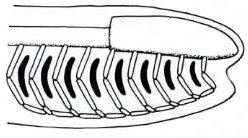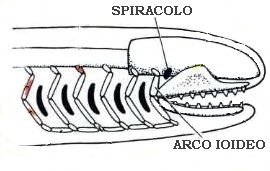|
In this article, after a brief introduction
respect the characteristic two types of sharks respiraton , the spiracle
is described. It is a small hole set behind the eye of these animals,
whose open/close is operated by an unintentional muscle. In the brief
article the author exposes his opinion about the function of this
opening and reflects on the motive for which only some sharks seem to
possess it, with different form and dimensions, while in other kinds the
spiracle is not clear visible.
The respiraton in the sharks happens through the contact among the water
and the blood of the thin gill plates of these animals.
To this level it happens the gaseous exchange among the contained oxygen
in the water, that is released and diffused in all the organs of the
shark and the carbonic anhydride, that is eliminated to the outside of
the organism. To realize these exchanges the slide of the water through
the gills it has to be continuous, otherwise the shark would risk the
death for asphyxia.
In these animals the types of respiraton are two, tied up to the
characteristics of the single kinds. The pelagic sharks, that swim aloft
sea, have to stir in continuation, also during the sleep, with the mouth
seeds opened to allowe the continuous passage of the water and the
oxygenation of the gills.
The bentonic sharks instead, that swim to narrow contact with the fund,
can be also firm for long periods, inhaling the water with the mouth and
forcedly pushing the water through the gills
.
A component connected to the respiraton of the sharks is the SPIRACLE a
small hole set behind the eye of these animals whose open/close is
connected to the action of an unintentional muscle.
The spiracle is used by the shark as a pomp, to inhale the oxygenated
water and to push then her toward the gills, integrating the action of
the mouth.
In the bentonic kinds this opening results of greater dimensions and
therefore more functional, but it seems as an additional element to
disposition to always be used for a respiraton more effective.
The use of the spiracle results particularly profit to the shark when
the mouth of the animal is found to narrow contact with the backdrop,
avoiding in this way the entrance of useless sediments and deposits.
In many pelagic sharks the spiracle is generally of least dimensions and
doesn't seem to have some function, especially in proportion to the mass
of the animals in which it is present and it is probably the residue of
a commune evolution.
(Instead the spiracle is very great in the rays, "narrow relatives" of
the sharks and used to the place of the mouth to inhale the water and to
oxygenate the gills)
Also in exemplary of notable dimensions of white
shark (Carcharodon carcharias) and tiger shark (Galeocerdo cuvier) the
presence of the spiracle has been underlined but it results of such
dimensions, almost invisible to naked eye, not to make to think to some
tied up function to the respiraton.
The origin of this opening is had by the transformation of a gill slit
it posts between the jaw and the ioideus arc of the jaw of the
cartilagineus fishes and probably it is present today in all the kinds
of known sharks.


Evolution of Vertebrates jaw. The gill
slit between the jaw
and the ioideus arc turns him into the spiracle
From the anatomical analysis of some exemplary
ones, above all pelagic, the spiracacle doesn't result however visible,
and we can suppose then that this opening can lose the contact with the
outside closing herself with an edge of fabric.
This hypothesis would explain the motive for which in numerous kinds of
shark the spiracle is clearly visible, while in others it is absent the
opening with the outside but it is probably present the inside
anatomical modification to maxillary level.
Marco Angelozzi -
www.prionace.it
E' assolutamente vietata la
riproduzione, anche parziale, del testo e delle
foto presenti in questi articoli, senza il consenso dell'autore
|
|
![]()